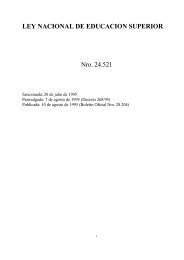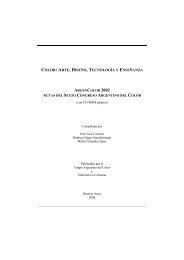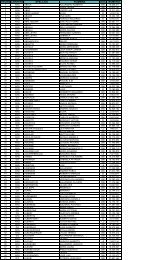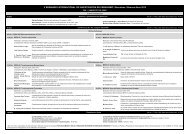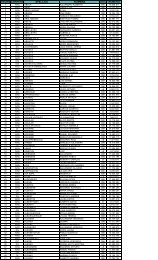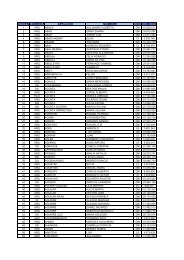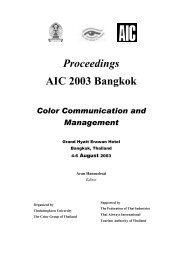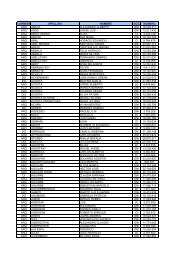AIC 2004 Color and Paints, Interim Meeting <strong>of</strong> <strong>the</strong> International Color Association, ProceedingsWe have paid special attention to <strong>the</strong> so-called <strong>genetic</strong> <strong>element</strong>s <strong>of</strong> <strong>the</strong> artistic <strong>image</strong>: light,matter, space and time, where colour remains <strong>as</strong> an important <strong>element</strong> in <strong>the</strong> artistic language.At <strong>the</strong> beginning <strong>of</strong> March 2004, a <strong>the</strong>oretical-practical seminar w<strong>as</strong> carried out with <strong>the</strong>Buenos Aires National Institute <strong>of</strong> Art pr<strong>of</strong>essor Mauricio Rinaldi, which also works in <strong>the</strong>lighting area for <strong>the</strong> Colon Theatre <strong>of</strong> Buenos Aires, Argentina, and is a relevant member <strong>of</strong><strong>the</strong> Argentine Colour Group. The seminar w<strong>as</strong> called “<strong>Light</strong>ing in Art and Stage Design”.In this seminar, <strong>the</strong> light work w<strong>as</strong> treated from a b<strong>as</strong>ically technical point <strong>of</strong> view (electricsystems, power ph<strong>as</strong>e and distribution, external-internal knowledge about different spotlightsand mixing-light desks, etc.) to a special focus on <strong>the</strong> significance, that is, not just on <strong>the</strong> howbut on <strong>the</strong> why to use a certain lighting sketch. Aes<strong>the</strong>tics <strong>of</strong> light and communication <strong>the</strong>orieswere also analysed, to come up with <strong>the</strong> consideration <strong>of</strong> light <strong>as</strong> a communication <strong>element</strong>inside <strong>the</strong> object <strong>of</strong> art, <strong>as</strong> well <strong>as</strong> stage design or pl<strong>as</strong>tic arts.The experience <strong>of</strong> working with 49 students w<strong>as</strong> very interesting. They made very complexnarrative pieces <strong>of</strong> artwork, in which light w<strong>as</strong> considered part <strong>of</strong> <strong>the</strong> communicative exercise.The above-specified members <strong>of</strong> <strong>the</strong> research group have developed a communication aboutthis experience. The importance <strong>of</strong> this research lies on <strong>the</strong> integration <strong>of</strong> <strong>the</strong> <strong>Light</strong> andMaterials Laboratory 1 into <strong>the</strong> Faculty <strong>of</strong> Fine Arts <strong>of</strong> Granada University teaching practice.Images <strong>of</strong> this experience show <strong>the</strong> sequence and changes <strong>of</strong> paradigm in visual languagesconfiguration. The relationship <strong>of</strong> light and matter not only shows colour but o<strong>the</strong>r verycomplex and richness phenomena that take part in <strong>the</strong> construction <strong>of</strong> <strong>image</strong>s. That is, <strong>the</strong>opacity and translucency contr<strong>as</strong>ts, different reflection stages that will indicate significant<strong>as</strong>pects and introduce matter blendings in matter structure surfaces, etc.The work <strong>of</strong> <strong>the</strong> Research Group HUM-480 studies this open systems <strong>of</strong> <strong>genetic</strong> <strong>element</strong>sthat are articulated <strong>the</strong>mselves within <strong>the</strong> appearance system. The relationship <strong>of</strong> light andmatter <strong>as</strong> an actual specific space-time experience, in which <strong>the</strong>y are configured within ageometry that evidences <strong>the</strong> complexity and richness <strong>of</strong> <strong>image</strong>s construction. These <strong>image</strong>sare not possible without a reception; in <strong>the</strong> same way colour sensation would not occurwithout a receptor that should eventually transmute <strong>the</strong> reflected radiation into coloursensation.A new scope <strong>of</strong> development is happening in visual and pl<strong>as</strong>tic art:Artists whose art works are in re-definition and making wide new strategies in artlanguage.Open interpretation systems in a hermeneutic key: materializations, referential and virtual<strong>image</strong>s. Senses or real interpretations. Senses or referential interpretations. Slidings andtransgressions, etc.Redefinition <strong>of</strong> nature mute language into pl<strong>as</strong>tic and visual <strong>image</strong>s language:interpretative projection. Constructive projection. Pedagogical projection.From art, <strong>the</strong> relevance on <strong>the</strong>se studies set <strong>the</strong> b<strong>as</strong>is on visual languages, <strong>the</strong> narration bymeans <strong>of</strong> which we understand and create worlds.1 The <strong>Light</strong> and Materials Laboratory is a creative and technical research project with <strong>the</strong> purpose <strong>of</strong>integration in <strong>the</strong> new syllabus <strong>of</strong> <strong>the</strong> Faculty <strong>of</strong> Fine Arts studies.266
AIC 2004 Color and Paints, Interim Meeting <strong>of</strong> <strong>the</strong> International Color Association, ProceedingsNext, we will show some artists’ work that can exemplify all what h<strong>as</strong> been exposed.Björn Dahlen: Club Superspace 3, Charm-Sphären(Deuterium Attezione), installation’s view.Kunstverein in Hamburg, 2001. Andrómeda, wood,neon and mixed media, 1999. Artist, sculptor andstage designer born in 1974 in Munich, Dahlenworks in Berlin. The installations retain <strong>the</strong> spirit <strong>of</strong>arte povera because <strong>of</strong> <strong>the</strong> austerity and simplicity<strong>of</strong> his work. Materials used: neon tubes, wood, video monitors. S<strong>of</strong>t techno lighting, romanticor multicolour, reflects intersideral space recalling <strong>the</strong> galactic myth by means <strong>of</strong> light.Martin Creed: Work Nr. 227, <strong>the</strong> light in a room going on and <strong>of</strong>f,frequency every 5 seconds, variable material and dimension, 2000. Thisartist uses gallery room <strong>as</strong> container and me<strong>as</strong>urement unity. Born in 1968in England, he lives and works in Italy. He uses light <strong>as</strong> modelling<strong>element</strong> in <strong>the</strong> exhibition space. The room is empty and <strong>the</strong> normalillumination is substituted with intermittent lighting that blinks in fivesecondgaps. With this minimalist installation <strong>the</strong> artist catches <strong>the</strong>attention over physical space through <strong>the</strong> play <strong>of</strong> light.Carsten Höller: <strong>Light</strong> wall, installation’s view, Prada Foundation, Milan,2000. This artist creates a successful combination <strong>of</strong> art and science. Hetries to wide and spread <strong>the</strong> boundaries <strong>of</strong> human perception, searchingpsychological sensations. If we want to open our perceptive horizon, weshould give up our habits and certainties. In this piece <strong>of</strong> art, 1920 bulbsemitted light and heat, switching on and <strong>of</strong>f in a 7,8 Hz. frequency g<strong>as</strong>p.Even with <strong>the</strong>ir eyes shut, <strong>the</strong> spectators could not hide from light. Brain iscompared to an electric system that synchronizes external impulses.267



